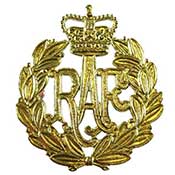
Experiences of post-war National Service in the RAF (3 of 4)
Personal recollections by Norman Groocock

In November 1954 I was called up for National Service and assigned to the Royal Air Force.
Basic training at Cardington and Hednesford
The assembly point for new recruits was Cardington where we were paraded in the old airship hangers which were really vast. We were there for about a week while we had medicals and injections and some very basic intelligence tests. We were also issued with uniforms and kit, and were allocated to one of the four basic training camps. So the next week I and about 90 others were bussed to Hednesford camp which is in the middle of nowhere in the moorland on Cannock Chase.
We were housed in wooden huts holding about 30 airmen with a large black cast iron stove in the centre. Being the middle of winter with snow on the ground, we kept this stove burning as long as possible but every morning it had to be emptied and the fire started again. On inspection days it had to be 'blacked' and at all times the floor had to be kept in a polished state. So we never wore our boots in the hut and slid about on cloths. Only about the first dozen or so folk got hot water for their shower and as the water storage tank was up on legs in the middle of the camp, the temperature of the water was 'bracing'.
The training involved a lot of marching about, rifle drill and how to dismantle and reassemble a Bren gun. A lot of emphasis was put on the latter. First there was the naming of parts, then much practice at taking the gun apart and putting it back together and finally doing the whole lot blindfolded and in a restricted time to simulate having to do it in the dark if it jammed.
Then there was bayonet practice and an obstacle course and we had to take our turn on guard duty and in the cookhouse.
I spent my 21st birthday on cookhouse duty - 6 am breaking dozens of eggs into a massive cauldron to make scrambled egg for breakfast for several hundred airmen.
We had a spell in the tear gas hut where we went in with our gas masks on and the had to take them off just before we came out. This was not a pleasant experience.
One of the highlights of the course was a talk from the medical officer about personal hygiene and especially venereal disease with some graphic pictures. As this took place in the week before Christmas, we were wished 'A happy syphilis and a merry gonorrhoea'.
We had firing range tests at various distances. I disgraced myself on the 100 yard range (could have been the 200 yard). Our shooting stations were numbered and the targets had the same number. To pass we had to get 5 out of 6 of the bullets within the target which had various rings down to the centre bulls eye. For some reason I got the target number wrong and proceeded to put all my bullets into my neighbour's target. He was furious as he was trying to get his sharpshooter badge which would entitle him to extra pay during his service. He needed to get all his bullets into the inner ring or the bulls eye. Three of the 12 bullets were in the next ring out and it was not possible to tell which were his and which were mine. However he was given the benefit of the doubt and his badge and I was given a roasting. However we both passed.
Assessment of potential officer material
We were all assessed for 'potential officer material' (POM) but it was difficult to get a commission as a national serviceman. Only one of our intake was chosen. He was a nice chap but not overly bright. However he had been to a minor public school and had joined their air cadet corps, so I think he created the right impression on the interviewers.
Work for remainder of the National Service
During the last week of training we were asked what branch of the airforce we wished to be in. We were given five choices. I chose aircraft mechanic or fitter, radio mechanic or fitter and nursing attendant. Seemingly they were short of volunteers for the latter, so that was my lot and it did not turn out badly.
Pay
The pay as an ordinary aircraftman was 4 shillings a day, for seven days a week. I saved one shilling a day in my post office account and the rest I needed for the odd cake from the refreshment van that come round at morning break and for my rail fare home when I got weekend leave. What Dick Hibberd wrote about remembering one's service number is quite right! Mine was 2740297.
Afterwards
I was demobbed in November 1956 and then had to think about picking up the pieces of my life.
Page contributed by Norman Groocock
If you can add anything to this page or provide a photo, I would be pleased if you would contact me.
Text and images are copyright
sources: early 20th century material
sources: ww2 home front and other material
contact
the webmaster/author/researcher/editor
privacy policy
















